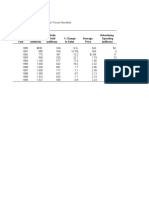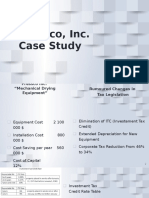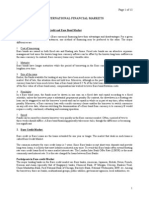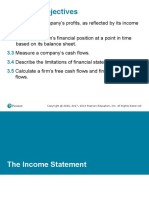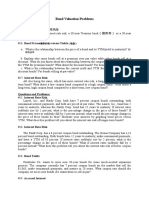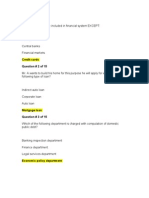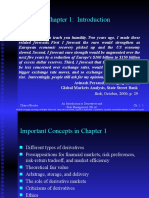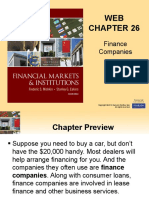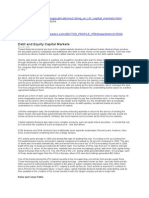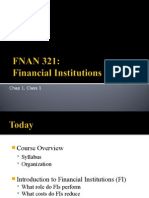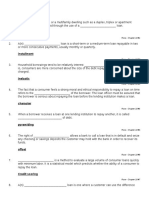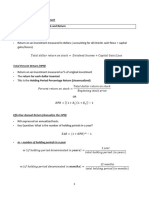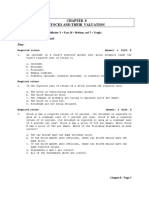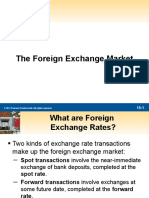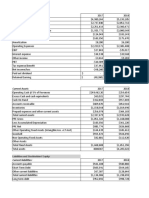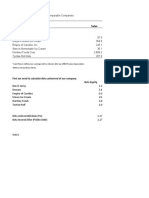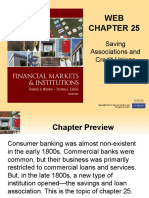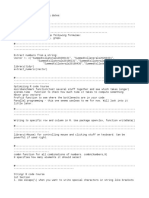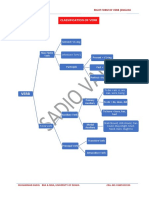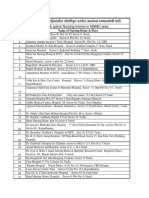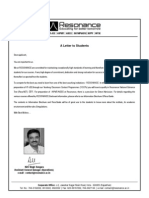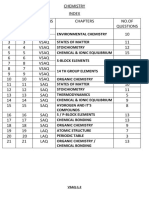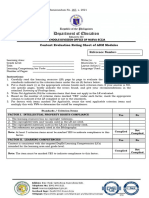The International Financial System: All Rights Reserved
The International Financial System: All Rights Reserved
Uploaded by
Irakli SaliaCopyright:
Available Formats
The International Financial System: All Rights Reserved
The International Financial System: All Rights Reserved
Uploaded by
Irakli SaliaOriginal Title
Copyright
Available Formats
Share this document
Did you find this document useful?
Is this content inappropriate?
Copyright:
Available Formats
The International Financial System: All Rights Reserved
The International Financial System: All Rights Reserved
Uploaded by
Irakli SaliaCopyright:
Available Formats
CHAPTER 16
The
International
Financial
System
Copyright © 2012 Pearson Prentice Hall.
All rights reserved.
Chapter Preview
The international financial system has grown
in importance as the U.S. economy has
become more interdependent with the
economies of the rest of the world. In this
chapter, we examine the differences between
fixed and managed exchange rate systems.
© 2012 Pearson Prentice Hall. All rights reserved. 16-2
Chapter Preview
We also look at the controversial role of capital
controls and the IMF in the international setting.
Topics include:
Intervention in the Foreign Exchange Market
Balance of Payments
Exchange Rates Regimes in the International
Financial System
Capital Controls
The Role of the IMF
© 2012 Pearson Prentice Hall. All rights reserved. 16-3
Intervention in the Foreign
Exchange Market
Foreign exchange markets are not free of
government intervention.
Foreign exchange interventions occur
when central banks engage in international
transactions to influence exchange rates.
© 2012 Pearson Prentice Hall. All rights reserved. 16-4
Intervention in the Foreign Exchange
Market: the Money Supply
The first step is to understand the impact on
the monetary base and the money supply
when a central bank intervenes in the
foreign exchange market.
International reserves refers to a central
bank’s holdings in a foreign currency.
© 2012 Pearson Prentice Hall. All rights reserved. 16-5
Intervention in the Foreign Exchange
Market: the Money Supply
Suppose the Fed sells $1 billion in a foreign currency in
exchange for $1 billion in U.S. currency.
Federal Reserve System
Assets Liabilities
Foreign –1 billion Currency or –1 billion
Assets Reserves
(international (Monetary
reserves) Base)
Results:
─ Fed holding in international reserves falls by 1 billion.
─ Currency in circulation falls by 1 billion.
© 2012 Pearson Prentice Hall. All rights reserved. 16-6
Intervention in the Foreign Exchange
Market: the Money Supply
Suppose the Fed sells $1 billion in a foreign
currency in exchange for a check written on
a domestic bank.
Federal Reserve System
Assets Liabilities
Foreign –1 billion Deposits with –1 billion
Assets the Fed
(international (reserves)
reserves)
© 2012 Pearson Prentice Hall. All rights reserved. 16-7
Intervention in the Foreign Exchange
Market: the Money Supply
In either case, we draw the same conclusion:
a central bank’s purchase of domestic
currency and corresponding sale of a foreign
currency leads to an equal decline in its
international reserves and the monetary
base.
© 2012 Pearson Prentice Hall. All rights reserved. 16-8
Intervention in the Foreign Exchange
Market: the Money Supply
Obviously, the opposite is true if the
transaction reversed: a central bank’s sale of
domestic currency and corresponding
purchase of a foreign currency leads to an
equal increase in its international reserves
and the monetary base.
© 2012 Pearson Prentice Hall. All rights reserved. 16-9
Inside the Fed
Before we move on, it’s worth spending a
moment to talk about the actual process of
intervention.
First, the U.S. Treasury and the Fed’s
FOMC decide to intervene. This occurs
through a variety of conference calls during
the day between the Treasury, the BOG, and
the New York Fed.
© 2012 Pearson Prentice Hall. All rights reserved. 16-10
Inside the Fed
If an intervention is called for, the manager of
the desk at the New York Fed has his traders
carry-out the prescribed purchase or sale of
currency on behalf of the Treasury.
In the interim, the staff of the FOMC
continues to develop reports and other
information about developments in domestic
and foreign markets.
© 2012 Pearson Prentice Hall. All rights reserved. 16-11
Intervention in the Foreign Exchange
Market: the Money Supply
Once we understand the impact of
purchases or sales, the Fed still has a
decision to make.
A central bank, knowing these results, can
engage in one of two types of foreign
exchange interventions:
─ Unsterilized
─ Sterilized
© 2012 Pearson Prentice Hall. All rights reserved. 16-12
Intervention in the Foreign Exchange
Market: Unsterilized Intervention
Unsterilized:
Federal Reserve System
Assets Liabilities
Foreign +1 billion Currency or +1 billion
Assets Reserves
(international (Monetary
reserves) Base)
Results:
─ International reserves, 1 billion
─ Monetary base, 1 billion
─ The analysis is in Figure 16.1, Et
© 2012 Pearson Prentice Hall. All rights reserved. 16-13
Intervention in the Foreign Exchange
Market: Unsterilized Intervention
1. Initially, the
purchase of dollars
decreases the
money supply, and
demand shifts from
D1 to D2.
2. The equilibrium
exchange rate rises
from E1 to E2 as the
expected return on
dollar assets rises.
© 2012 Pearson Prentice Hall. All rights reserved. 16-14
Intervention in the Foreign Exchange
Market: Sterilized Intervention
Sterilized:
Federal Reserve System
Assets Liabilities
(Foreign Assets) (Monetary Base)
International –1 billion Curreny or 0
Reserves Reserves
Government +1 billion
Bonds
Results:
─ International reserves, 1 billion
─ Monetary base unchanged
─ Et unchanged: no shift in demand
© 2012 Pearson Prentice Hall. All rights reserved. 16-15
Balance of Payments
This is the method for measuring the effects
of international financial transactions on the
economy.
The balance of payments is a booking
system for recording all receipts and
payments that have a direct bearing on the
movement of funds between nations.
© 2012 Pearson Prentice Hall. All rights reserved. 16-16
Balance of Payments
The current account shows international
transactions that involve currently produced
goods and services.
The trade balance is part of this account,
and shows the difference between exports
and imports
© 2012 Pearson Prentice Hall. All rights reserved. 16-17
Balance of Payments
The capital account shows the net
receipts from capital transactions. Capital
flows into a country are recorded as
receipts, whereas outflows are registered
as payments
© 2012 Pearson Prentice Hall. All rights reserved. 16-18
Balance of Payments
Given these definitions, the following
equation holds:
Current Account Capital Account
Net Change in Governmental International Reserves
© 2012 Pearson Prentice Hall. All rights reserved. 16-19
Balance of Payments
The rapid growth in the U.S. current account
deficit in recent years, which is now close to
$1 trillion, has raised serious concerns about
the impact (negative) on the U.S. economy.
We’ll explore this briefly.
© 2012 Pearson Prentice Hall. All rights reserved. 16-20
Global: Economist Concerns
about the Current Account Deficit
The deficit (about $250b in 2009) concerns
economists for several reasons:
1. Indicates that at the current exchange rate,
foreigners demand fewer U.S. exports than
American’s demand imports.
2. Foreigners’ claims on U.S. assets are
growing, possibly leading to a decreased
demand for dollars over time.
© 2012 Pearson Prentice Hall. All rights reserved. 16-21
Exchange Rate Regimes in the
International Financial System
There are two basic types of exchange rate
regimes in the international financial
system:
─ Fixed exchange rate regime
─ Floating exchange rate regime
© 2012 Pearson Prentice Hall. All rights reserved. 16-22
Exchange Rate Regimes in the International
Financial System: Fixed Exchange Rate
In a fixed exchange rate regime, the
values of currencies are kept pegged
relative to one currency so that exchange
rates are fixed.
The currency against which the others are
pegged is known as the anchor currency.
© 2012 Pearson Prentice Hall. All rights reserved. 16-23
Exchange Rate Regimes in the International
Financial System: Floating Exchange Rate
In a floating exchange rate regime, the
values of currencies are allowed to fluctuate
against one another.
When countries attempt to influence
exchange rates via buying and selling
currencies, the regime is referred to as a
managed float regime (or a dirty float).
© 2012 Pearson Prentice Hall. All rights reserved. 16-24
Fixed Exchange Rate Systems
Bretton Woods
1. Created the International Monetary Fund (IMF), which
sets rules and provides loans to deficit countries
2. Setup the International Bank for Reconstruction and
Development (World Bank), which provides loans to
developing countries
© 2012 Pearson Prentice Hall. All rights reserved. 16-25
Fixed Exchange Rate Systems
Bretton Woods
3. The U.S. emerged from WWII as the world’s largest
economic power. The U.S. dollar was called the
reserve currency, meaning it was used by other
countries to denominate the assets they held in
international reserves.
4. The system was abandoned in 1971.
5. Even post-1971, the dollar was the “reserve currency”
in which most international financial transactions were
conducted. But, as we will see next, the euro has
challenged that status.
© 2012 Pearson Prentice Hall. All rights reserved. 16-26
Euro’s Challenge to the
US dollar
With the introduction of the euro in 1999, the
dollar is losing position as the reserve currency.
With the euro integrating European finance, it
is more likely that international transactions will
use the euro. However, the European Union
must start to function as a cohesive political
entity for the euro to gain further ground –
which is unlikely in the near future.
© 2012 Pearson Prentice Hall. All rights reserved. 16-27
Fixed Exchange Rate Systems
Now we turn to how fixed exchange rate
systems work. The next slide shows this
using the supply and demand analysis of the
foreign exchange market that we examined in
previous chapters.
© 2012 Pearson Prentice Hall. All rights reserved. 16-28
Fixed Exchange Rate Systems:
How they work
There are essentially two situations where a
central bank will act in the foreign exchange
market. There are when the domestic
currency is either:
─ Overvalued
─ Undervalued
© 2012 Pearson Prentice Hall. All rights reserved. 16-29
Fixed Exchange Rate Systems:
How they work
When the domestic currency is overvalued, the
central bank must purchase domestic currency to
keep the exchange rate fixed. As a result, the
central bank loses international reserves.
When the domestic currency is undervalued, the
central bank must sell domestic currency to keep
the exchange rate fixed. As a result, the central
bank gains international reserves.
© 2012 Pearson Prentice Hall. All rights reserved. 16-30
Fixed Exchange Rate Systems:
How they work
These results can be seen in the figure on the
next slide. Part (a) shows the impact of central
bank actions when the domestic currency is
overvalued. Part (b) shows the impact when the
domestic currency is undervalued.
© 2012 Pearson Prentice Hall. All rights reserved. 16-31
Intervention in a Fixed
Exchange Rate System
© 2012 Pearson Prentice Hall. All rights reserved. 16-32
Analysis of Figure 16.2: Intervention
in a Fixed Exchange Rate System
In panel a, exchange rate at Epar is
over-valued.
─ Central bank buys domestic currency to shift
demand curve to D2
In panel b, exchange rate at Epar is
under-valued.
─ Central bank sells domestic currency to shift
demand curve to D2
© 2012 Pearson Prentice Hall. All rights reserved. 16-33
Fixed Exchange Rate Systems:
How they work
Devaluation can occur when the domestic currency
is overvalued. Eventually, the central bank may run
out of international reserves, eliminating its ability to
prevent the domestic currency from depreciating.
Revaluation will occur when the central bank
decides to stop intervening when its domestic
currency is undervalued. Rather than acquiring
international reserves, it lets the par value of the
exchange rate reset to a higher level.
© 2012 Pearson Prentice Hall. All rights reserved. 16-34
Fixed Exchange Rate Systems:
How they work
If there is perfect capital mobility, then a sterilized
exchange rate intervention keep the exchange
rate at Epar.
An important implication—if a country ties its
exchange rate to an anchor currency of a larger
country, it loses control of its monetary policy.
However, this does force the more disciplined
policies of the larger country on the smaller
country—usually ensuring a low inflation rate.
© 2012 Pearson Prentice Hall. All rights reserved. 16-35
Fixed Exchange Rate Systems:
How they work
Currency boards are the extreme example
of the last point. With a currency board, the
domestic currency is backed 100% by a
foreign currency. These have been
established in Hong Kong, Argentina, and
Estonia, to name a few. The most extreme
example is dollarization, where a country
adopts the currency of a foreign country.
© 2012 Pearson Prentice Hall. All rights reserved. 16-36
Argentina’s Currency Board
Adopted in 1991 to end a long history of
monetary instability.
Peso/dollar exchange rate fixed, and rate
guaranteed by the central bank.
Early success was stifled by a mass
exchange of pesos for dollars—real GDP
shrunk and unemployment rose to 15% in
1995.
© 2012 Pearson Prentice Hall. All rights reserved. 16-37
Argentina’s Currency Board
Central bank could do nothing to control
this—exchange rate was fixed. But world
organizations (World Bank, IMF) helped
out.
Another recession in 1999 eventually lead
to the collapse of the currency board in
2002. The peso depreciated by 70%, and a
financial crisis ensued.
© 2012 Pearson Prentice Hall. All rights reserved. 16-38
Dollarization
Panama has been dollarized since its inception,
and El Salvador and Ecuador have recently
adopted dollarization.
Avoids a central bank creating inflation, and
eliminates speculative attacks on a currency.
However, a country cannot pursue its own
monetary policy, and it loses the revenue a
government receives by issuing currency
(known as seigniorage).
© 2012 Pearson Prentice Hall. All rights reserved. 16-39
Foreign Exchange Crisis
of September 1992
Following the reunification of Germany in
October 1990, the German central bank
faced inflationary pressure. To control
monetary growth, the central bank raised
interest rates to double-digits.
The consequences are detailed on the next
slide.
© 2012 Pearson Prentice Hall. All rights reserved. 16-40
Exchange Rate Crisis
of September 1992
1. The increase in German
interest rates lowered
expected returns on
British pounds, shifting
demand from D1 to D2.
2. The equilibrium rate was
below the lower exchange
rate limit for the time.
3. Required England pursue
a contraction or Germany
to lower rates. Neither
would do this.
4. Demand shifted to D3—a
huge sell-off of pounds!
© 2012 Pearson Prentice Hall. All rights reserved. 16-41
The Practicing Manager:
Profiting from a FX Crisis
September 1992, £ overvalued
Once traders know central banks can’t
intervene enough, £ only head one direction,
─ One-sided bet, “heads I win, tails I win”
─ Traders sell £, buy DM
─ £ 10% after September 16
• Citibank makes $200 million
• Soros makes $1 billion
© 2012 Pearson Prentice Hall. All rights reserved. 16-42
Case: Recent Foreign
Exchange Crisis
Emerging markets have experienced recent
foreign exchange crisis. These include Mexico
(1994), East Asia (1997), Brazil (1999), and
Argentina (2001).
In each case, demand shifted to the left, and
the resulting equilibrium was below the pegged
value for the currency. Central banks needed to
sell dollars and buy domestic currency.
© 2012 Pearson Prentice Hall. All rights reserved. 16-43
Case: Recent Foreign
Exchange Crisis
At first successful, each central bank was
later faced with further speculative attacks.
Demand curve moved further to the left!
The central bank was eventually forced to
give up its defense and let the domestic
currency depreciate.
© 2012 Pearson Prentice Hall. All rights reserved. 16-44
Case: How China Accumulated over
$2 trillion in International Reserves
In 1994, China pegged the yuan to the dollar.
High productivity and low inflation rate lead
to an increase in value of the yuan. Expected
return for yuan assets increased, and
demand shifted to the right.
To keep the yuan from appreciating, the
central bank purchased dollars.
© 2012 Pearson Prentice Hall. All rights reserved. 16-45
Case: How China Accumulated over
$2 trillion in International Reserves
This has created problems for Chinese
authorities.
─ They now own a lot of low-return U.S. assets
─ Chinese goods have become so cheap that
countries are threatening to enact trade
barriers.
─ Policy may lead to high inflation in the future.
© 2012 Pearson Prentice Hall. All rights reserved. 16-46
Case: How China Accumulated over
$2 trillion in International Reserves
This has created problems for Chinese
authorities.
─ In July 2005, Chinese officials did let the yuan
rise 2.1%
─ Despite efforts to avoid a fixed peg, China
re-imposed the peg in 2008 during the global
financial crisis. But then dropped it in 2010.
© 2012 Pearson Prentice Hall. All rights reserved. 16-47
Case: How China Accumulated over
$2 trillion in International Reserves
Why did they do this, despite the problems?
─ Exports hum under the policy – the price of
their exports are low in international markets
─ Gives China assets to fend off a yuan
speculative attack in the future
© 2012 Pearson Prentice Hall. All rights reserved. 16-48
Exchange Rate Regimes in the International
Financial System: Managed Float
Central banks are reluctant to give up their
ability to intervene in foreign exchange
markets.
Limiting changes in exchange rates makes
it easier for firms and individual to plan
purchases/sales in the international
marketplace.
© 2012 Pearson Prentice Hall. All rights reserved. 16-49
Exchange Rate Regimes in the International
Financial System: Managed Float
Countries with a trade surplus are reluctant
to allow their currencies appreciate since it
hurts domestic sales.
On the other hand, countries with a trade
deficit do not want to see their currency
lose value since it makes foreign goods
more expensive.
© 2012 Pearson Prentice Hall. All rights reserved. 16-50
Capital Controls
Control on Capital Outflows
─ Controls on outflows are unlikely to work
─ Seldom effective during a crisis
─ May actually increase the problem by leading
to an increase in capital flight
─ Controls often lead to corruption
─ May lull government authorities into thinking
that they don’t need to make financial system
reforms.
© 2012 Pearson Prentice Hall. All rights reserved. 16-51
Capital Controls
Controls on Capital Inflows
─ Somewhat supported for its ability to reduce the
likelihood of a crisis
─ May block productive resources from entering a
country
─ Can lead to corruption
─ However, may be a good method for controlling
risk-taking on the part of financial institutions
© 2012 Pearson Prentice Hall. All rights reserved. 16-52
The Role of the IMF
1. There is a need for international lender of
last resort (ILLR) and IMF has played
this role
2. ILLR creates moral hazard problem
3. IMF needs to limit moral hazard
─ Lend only to countries with good bank
supervision
4. Need to do ILLR role fast and infrequently
© 2012 Pearson Prentice Hall. All rights reserved. 16-53
The Role of the IMF:
How Should It Operate?
1. Make a clear statement that it will not lend
unless needed reforms are enacted.
2. Tight macro-policies give appearance of
“austerity programs” labeled as anti-
growth. Should focus on micro-fixes.
3. Needs to act quickly when needed.
© 2012 Pearson Prentice Hall. All rights reserved. 16-54
Chapter Summary
Intervention in the Foreign Exchange
Market: we examined both unsterilized and
sterilized interventions and the impact each
has on the domestic financial system.
Balance of Payments: the bookkeeping
system for funds moving between nations
was explored.
© 2012 Pearson Prentice Hall. All rights reserved. 16-55
Chapter Summary (cont.)
Exchange Rates Regimes in the
International Financial System: we
examined fixed, managed fixed, and
floating regimes, and the impact each has
on the financial system.
Capital Controls: controls on either inflows
and outflows are difficult to justify given the
negative aspects of either set of controls.
© 2012 Pearson Prentice Hall. All rights reserved. 16-56
Chapter Summary (cont.)
The Role of the IMF: the debate on the
need and role of the IMF remains a hotly
debated topic.
© 2012 Pearson Prentice Hall. All rights reserved. 16-57
You might also like
- Porsche 993 Workshop ManualsDocument20 pagesPorsche 993 Workshop Manualsmarilyn100% (64)
- Overview of Ocean Carriers CaseDocument2 pagesOverview of Ocean Carriers CaseIrakli SaliaNo ratings yet
- Chapter 10Document163 pagesChapter 10HumbertNo ratings yet
- Pressco Inc. Case StudyDocument18 pagesPressco Inc. Case StudyIrakli SaliaNo ratings yet
- Part Five: Financial MarketsDocument55 pagesPart Five: Financial MarketsQuỳnh NochiNo ratings yet
- 08 - Chapter 8Document71 pages08 - Chapter 8hunkieNo ratings yet
- Chap013 PDFDocument35 pagesChap013 PDFym5c2324No ratings yet
- ECON 201 Midterm 2012WDocument6 pagesECON 201 Midterm 2012WVaga boundedNo ratings yet
- Exhibit 4 Industry Information For Frozen NoveltiesDocument25 pagesExhibit 4 Industry Information For Frozen NoveltiesIrakli SaliaNo ratings yet
- Case 2 Eskimo Pie Corporation (Abridged)Document7 pagesCase 2 Eskimo Pie Corporation (Abridged)Irakli Salia100% (1)
- Pressco Inc. Case StudyDocument19 pagesPressco Inc. Case StudyIrakli SaliaNo ratings yet
- Why Do Financial Institutions ExistDocument39 pagesWhy Do Financial Institutions Existkafi100% (1)
- CH12 Mish11 EMBFMDocument40 pagesCH12 Mish11 EMBFMBradley Ray100% (1)
- Testbank - Multinational Business Finance - Chapter 12Document15 pagesTestbank - Multinational Business Finance - Chapter 12Uyen Nhi NguyenNo ratings yet
- CH 16Document43 pagesCH 16Angely May JordanNo ratings yet
- MBA711 - Answers To Book - Chapter 4Document16 pagesMBA711 - Answers To Book - Chapter 4Hạng VũNo ratings yet
- Chapter 1Document32 pagesChapter 1k60.2112340088No ratings yet
- Part Seven: THE Management of Financial InstitutionsDocument40 pagesPart Seven: THE Management of Financial InstitutionsIrakli SaliaNo ratings yet
- Chap 012Document15 pagesChap 012van tinh khuc100% (2)
- MCQ QuizDocument13 pagesMCQ QuizSharNo ratings yet
- International Financial MarketsDocument13 pagesInternational Financial Marketsmanojpatel5150% (4)
- Day-6 Cash FlowsDocument47 pagesDay-6 Cash FlowsRajsri RaajarrathinamNo ratings yet
- Non Deposits Week 10 PDFDocument24 pagesNon Deposits Week 10 PDFCynthia KesumaNo ratings yet
- Bond Valuation ProblemsDocument2 pagesBond Valuation ProblemsChloeNo ratings yet
- Chapter 13 The Stock MarketDocument7 pagesChapter 13 The Stock Marketlasha KachkachishviliNo ratings yet
- This Study Resource Was: Problems For Commercial Bank ManagementDocument6 pagesThis Study Resource Was: Problems For Commercial Bank ManagementPhạm Thành ĐạtNo ratings yet
- CONFUSEDDocument1 pageCONFUSEDLâm Thanh Huyền NguyễnNo ratings yet
- MAS2 BSAIS 2D Interest Rate and Return PPT 2Document172 pagesMAS2 BSAIS 2D Interest Rate and Return PPT 2Henry RufinoNo ratings yet
- Managing and Pricing Deposit Services: Peter Rose, Chapter 12Document34 pagesManaging and Pricing Deposit Services: Peter Rose, Chapter 12Dung Hoàng Khưu VõNo ratings yet
- Finance Chapter 19Document29 pagesFinance Chapter 19courtdubs50% (2)
- Lecture 21 ME Ch.15 Foreign Exchange MarketDocument50 pagesLecture 21 ME Ch.15 Foreign Exchange MarketAlif SultanliNo ratings yet
- Quiz 1Document8 pagesQuiz 1Waqas KhanNo ratings yet
- Transaction Exposure Chapter 11Document57 pagesTransaction Exposure Chapter 11armando.chappell1005No ratings yet
- On Financial InstitutionsDocument8 pagesOn Financial InstitutionsAnkit PoddarNo ratings yet
- BA4825 PP 1Document23 pagesBA4825 PP 1Ayla YahyayevaNo ratings yet
- Finance Companies: All Rights ReservedDocument29 pagesFinance Companies: All Rights ReservedIrakli SaliaNo ratings yet
- Financial Markets and Institutions 1Document32 pagesFinancial Markets and Institutions 1Hamza Iqbal100% (1)
- Debt and Equity MarketDocument2 pagesDebt and Equity MarketprahladtripathiNo ratings yet
- Mutual Funds and Other Investment Companies (Lecture Notes) PDFDocument8 pagesMutual Funds and Other Investment Companies (Lecture Notes) PDFNgọc Phan Thị BíchNo ratings yet
- Chapter 17 Multinational Cost of Capital and Capital StructureDocument26 pagesChapter 17 Multinational Cost of Capital and Capital StructurekegnataNo ratings yet
- Introduction To Financial MarketDocument30 pagesIntroduction To Financial Marketmaria evangelistaNo ratings yet
- Why Are Financial Institutions SpecialDocument49 pagesWhy Are Financial Institutions SpecialZaraNo ratings yet
- FIM Question Practice 2Document15 pagesFIM Question Practice 2Bao Khanh HaNo ratings yet
- Mishkin Fmi07 ppt13Document43 pagesMishkin Fmi07 ppt13Mariam OkropiridzeNo ratings yet
- LN10 EitemanDocument35 pagesLN10 EitemanFong 99No ratings yet
- Assignment 8 AnswersDocument6 pagesAssignment 8 AnswersMyaNo ratings yet
- Risk and Rate of ReturnDocument80 pagesRisk and Rate of ReturnMjhayeNo ratings yet
- ch18 PDFDocument34 pagesch18 PDFLê Chấn PhongNo ratings yet
- Chapter 22Document14 pagesChapter 22Yousef ADNo ratings yet
- Chapter 4Document48 pagesChapter 4ZhuangKaKit100% (1)
- International Finance Few Q&ADocument1 pageInternational Finance Few Q&ABrowse PurposeNo ratings yet
- CHP 1 - Introduction To Merchant BankingDocument44 pagesCHP 1 - Introduction To Merchant BankingFalguni MathewsNo ratings yet
- CH 01 Hull OFOD10 TH EditionDocument62 pagesCH 01 Hull OFOD10 TH EditionPedestal ConciergeNo ratings yet
- CHAPTER 2 Chapter 1 - Exchange Rate DeterminationDocument48 pagesCHAPTER 2 Chapter 1 - Exchange Rate Determinationupf123100% (2)
- Total Dollar Return: Investment Portfolio Management WEEK 1: A Brief History of Risk and ReturnDocument43 pagesTotal Dollar Return: Investment Portfolio Management WEEK 1: A Brief History of Risk and ReturnVenessa Yong100% (1)
- Chapter 6 The Risk and Term Structure of Interest RatesDocument13 pagesChapter 6 The Risk and Term Structure of Interest RatesSamanthaHandNo ratings yet
- Money Banking Practice Questions and AnswersDocument3 pagesMoney Banking Practice Questions and AnswersNihad RüstəmsoyNo ratings yet
- Stocks and Their Valuation: Multiple Choice: ConceptualDocument2 pagesStocks and Their Valuation: Multiple Choice: ConceptualKristel SumabatNo ratings yet
- Chapter Twenty-Two: Managing Interest Rate Risk and Insolvency Risk On The Balance SheetDocument23 pagesChapter Twenty-Two: Managing Interest Rate Risk and Insolvency Risk On The Balance SheetSagheer MuhammadNo ratings yet
- Practice Midterm 1 With SolutionsDocument6 pagesPractice Midterm 1 With SolutionsDenise ChenNo ratings yet
- Edoc - Tips Ch01 Financial Markets Money MarketDocument12 pagesEdoc - Tips Ch01 Financial Markets Money MarketKelvin LeongNo ratings yet
- Corporate Finance Practice Questions MidDocument9 pagesCorporate Finance Practice Questions MidFrasat IqbalNo ratings yet
- Chapter Seven: Risk Management For Changing Interest Rates: Asset-Liability Management and Duration TechniquesDocument37 pagesChapter Seven: Risk Management For Changing Interest Rates: Asset-Liability Management and Duration TechniquestusedoNo ratings yet
- Asifkhan - 69 - 17591 - 5 - CH 8 Foreign Exchange MarketDocument21 pagesAsifkhan - 69 - 17591 - 5 - CH 8 Foreign Exchange MarketMuddassir RazaNo ratings yet
- C02-Chapt 2-PPT PublisherDocument46 pagesC02-Chapt 2-PPT Publisherimran sialNo ratings yet
- Current Assets: Liabilities and Stockholders' EquityDocument9 pagesCurrent Assets: Liabilities and Stockholders' EquityIrakli SaliaNo ratings yet
- Popsicle Unilever 7.6% Klondike Empire of Carolin 5.4% Eskimo Pie Eskimo Pie 5.3% Snickers Mars 4.8% Weight Watchers H.J. Heinz 4.3%Document18 pagesPopsicle Unilever 7.6% Klondike Empire of Carolin 5.4% Eskimo Pie Eskimo Pie 5.3% Snickers Mars 4.8% Weight Watchers H.J. Heinz 4.3%Irakli SaliaNo ratings yet
- Pressco, Inc. Case Study: Corporate Finance II Irakli Salia 17-9 Nino Merabishvili 17-8Document18 pagesPressco, Inc. Case Study: Corporate Finance II Irakli Salia 17-9 Nino Merabishvili 17-8Irakli SaliaNo ratings yet
- No Tax Change ScenarioDocument52 pagesNo Tax Change ScenarioIrakli SaliaNo ratings yet
- Corona Virus Cases USADocument3 pagesCorona Virus Cases USAIrakli SaliaNo ratings yet
- Case IDocument20 pagesCase ICherry KanjanapornsinNo ratings yet
- Corporate Finance Case 2 ამხოსნაDocument3 pagesCorporate Finance Case 2 ამხოსნაIrakli SaliaNo ratings yet
- Eskimo Pie CorporationDocument1 pageEskimo Pie CorporationIrakli SaliaNo ratings yet
- Nasdaq GRMN 2019Document112 pagesNasdaq GRMN 2019Irakli SaliaNo ratings yet
- Part Seven: THE Management of Financial InstitutionsDocument40 pagesPart Seven: THE Management of Financial InstitutionsIrakli SaliaNo ratings yet
- Saving Associations and Credit Unions: All Rights ReservedDocument46 pagesSaving Associations and Credit Unions: All Rights ReservedIrakli SaliaNo ratings yet
- R Useful StuffDocument3 pagesR Useful StuffIrakli SaliaNo ratings yet
- Finance Companies: All Rights ReservedDocument29 pagesFinance Companies: All Rights ReservedIrakli SaliaNo ratings yet
- The Foreign Exchange Market: All Rights ReservedDocument54 pagesThe Foreign Exchange Market: All Rights ReservedIrakli SaliaNo ratings yet
- The Mortgage Markets: All Rights ReservedDocument55 pagesThe Mortgage Markets: All Rights ReservedIrakli SaliaNo ratings yet
- Punjab Assembly 2013Document36 pagesPunjab Assembly 2013asadaliNo ratings yet
- Chapter 14 - Instruments For Celestial NavigationDocument10 pagesChapter 14 - Instruments For Celestial NavigationBashir KharalNo ratings yet
- Aadhaar Update Form: Aadhaar Enrolment Is Free & VoluntaryDocument4 pagesAadhaar Update Form: Aadhaar Enrolment Is Free & VoluntaryPak or Ind cricket newsNo ratings yet
- Classroom Management Final DraftDocument9 pagesClassroom Management Final Draftapi-720402603No ratings yet
- Misconceptions, Myths, and Beliefs About Common Communicable DiseasesDocument24 pagesMisconceptions, Myths, and Beliefs About Common Communicable DiseasesDanah Verniz Baldoz100% (1)
- Urban TribesDocument5 pagesUrban TribesEnglishin FonquetaNo ratings yet
- Right Form of Verb English Classificatio PDFDocument10 pagesRight Form of Verb English Classificatio PDFSumanRoyNo ratings yet
- App14 - ICM SU 1348 FDocument35 pagesApp14 - ICM SU 1348 FArkitectNo ratings yet
- Assignment - 5 CategoriesDocument3 pagesAssignment - 5 Categoriesanusha joseNo ratings yet
- Lighting and Sound in FilmsDocument4 pagesLighting and Sound in Filmsapi-526939534No ratings yet
- Hydraulics Analysis of DamDocument12 pagesHydraulics Analysis of DamAngel AlbertNo ratings yet
- MOTOR and MEPDocument46 pagesMOTOR and MEPAbhirup BandyopadhyayNo ratings yet
- Hospital ListDocument7 pagesHospital ListSuresh RajaNo ratings yet
- Elvis PresleyDocument18 pagesElvis Presleysdaxxc100% (1)
- Best Manav Kaul Series 2Document4 pagesBest Manav Kaul Series 2muskanNo ratings yet
- World of Self, Family and Friends 0 - Welcome Reading 1 Monday Friendship Language ValuesDocument18 pagesWorld of Self, Family and Friends 0 - Welcome Reading 1 Monday Friendship Language ValuesVivianaNo ratings yet
- 1207 7aDocument24 pages1207 7aErika MoralesNo ratings yet
- Disposal and DivestmentDocument43 pagesDisposal and DivestmentIyay Calum BuhisanNo ratings yet
- Reso Guide (2011-12)Document48 pagesReso Guide (2011-12)Resonance Kota0% (1)
- 10 PHP MVC Frameworks Templating and FormsDocument28 pages10 PHP MVC Frameworks Templating and FormsNguyen Tuan Kiet (FGW DN)No ratings yet
- Liberty Union Vs Liberty CottonDocument2 pagesLiberty Union Vs Liberty Cottonrubbtuna100% (1)
- (English) This Technique CURED My Social Anxiety (DownSub - Com)Document10 pages(English) This Technique CURED My Social Anxiety (DownSub - Com)Асият НурмагомедоваNo ratings yet
- Chemistry Previous PaperDocument14 pagesChemistry Previous PaperK Vishnu Vardhan ReddyNo ratings yet
- Ebook Ebook PDF Routledge Handbook of Japanese Business and Management All Chapter PDF Docx KindleDocument41 pagesEbook Ebook PDF Routledge Handbook of Japanese Business and Management All Chapter PDF Docx Kindlelillie.nelson986100% (40)
- M.Arch Synopsis Structure PDFDocument5 pagesM.Arch Synopsis Structure PDFTeja VedulaNo ratings yet
- Internship Report 2Document57 pagesInternship Report 2selvathamizh27No ratings yet
- Company Name: Profood International Inc. Company ProfileDocument6 pagesCompany Name: Profood International Inc. Company ProfileJeric Israel0% (1)
- Content Evaluation Rating Sheet of ADM ModulesDocument5 pagesContent Evaluation Rating Sheet of ADM ModulesPrincess SupnetNo ratings yet
- Tallyerp9book Sample PageDocument24 pagesTallyerp9book Sample PagerudramanvNo ratings yet









